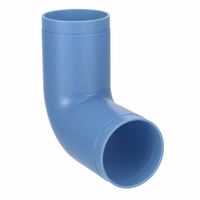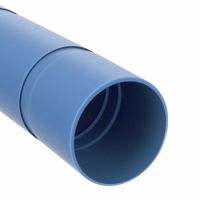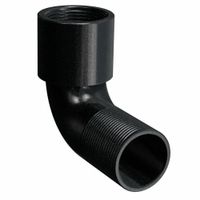Call +(254) 703 030 000 / 751 483 999 / 721 704 777
- Home
- Pipe Hose Tube Fittings
- Pipe Pipe Fittings
- Standard Pipe Pipe Fittings
- Polypropylene Pipe Systems
.....Read More
Frequently Asked Questions
What are the advantages of using polypropylene (PP) pipes and fittings?
Polypropylene (PP) pipes and fittings offer several advantages:
1. **Chemical Resistance**: PP is highly resistant to a wide range of chemicals, making it suitable for transporting aggressive fluids in industrial applications.
2. **Corrosion Resistance**: Unlike metal pipes, PP does not corrode, ensuring a longer lifespan and reduced maintenance costs.
3. **Lightweight**: PP pipes are lighter than metal pipes, facilitating easier handling, transportation, and installation, which can reduce labor costs.
4. **Durability**: PP has excellent impact resistance and can withstand physical stress, making it suitable for various environments.
5. **Thermal Resistance**: PP pipes can handle a wide range of temperatures, making them suitable for both hot and cold water applications.
6. **Low Thermal Conductivity**: This property helps in maintaining the temperature of the fluid being transported, reducing energy loss.
7. **Flexibility**: PP pipes are flexible, which allows for easy installation around obstacles and reduces the need for fittings.
8. **Non-Toxic**: PP is safe for potable water applications as it does not leach harmful substances.
9. **Smooth Interior Surface**: The smooth surface reduces friction, leading to lower pressure drops and increased flow efficiency.
10. **Cost-Effective**: PP pipes are generally more affordable than metal alternatives, offering a cost-effective solution for many applications.
11. **Recyclability**: PP is recyclable, making it an environmentally friendly option.
12. **Resistance to Scaling and Deposits**: The smooth interior prevents scaling and deposits, maintaining flow efficiency over time.
These advantages make PP pipes and fittings a popular choice in plumbing, industrial, and agricultural applications.
How do you connect polypropylene pipes and fittings?
To connect polypropylene pipes and fittings, follow these steps:
1. **Cutting**: Use a pipe cutter or fine-toothed saw to cut the polypropylene pipe to the desired length. Ensure the cut is straight and clean.
2. **Deburring**: Remove any burrs or rough edges from the cut end using a deburring tool or a utility knife. This ensures a smooth connection and prevents damage to the fittings.
3. **Cleaning**: Clean the pipe ends and the inside of the fittings with a clean cloth to remove any dust, dirt, or grease. This ensures a secure and leak-free connection.
4. **Marking**: Mark the insertion depth on the pipe using a marker. This helps ensure the pipe is inserted fully into the fitting.
5. **Heating**: Use a polypropylene pipe welding machine (socket fusion tool) to heat the pipe end and the fitting. Attach the appropriate size heating adapters to the machine, and allow it to reach the required temperature (usually around 260°C or 500°F).
6. **Fusion**: Once heated, quickly insert the pipe into the fitting, aligning them properly. Push until the marked depth is reached. Hold them together for a few seconds to ensure a proper bond.
7. **Cooling**: Allow the joint to cool naturally without any movement. This typically takes a few minutes. Do not apply any stress or load on the joint during this time.
8. **Inspection**: Check the joint for any visible gaps or misalignment. Ensure the connection is secure and leak-free.
9. **Testing**: Once all connections are made, conduct a pressure test to ensure the system is leak-proof.
These steps ensure a reliable and durable connection for polypropylene pipes and fittings.
What are the temperature and pressure limits for polypropylene pipes?
Polypropylene pipes are commonly used in plumbing and industrial applications due to their chemical resistance and durability. The temperature and pressure limits for polypropylene pipes depend on the specific type and grade of the material, as well as the design and application.
1. **Temperature Limits:**
- Polypropylene pipes can typically handle temperatures ranging from 0°C to 95°C (32°F to 203°F).
- For short-term exposure, some polypropylene pipes can withstand temperatures up to 110°C (230°F).
- At lower temperatures, polypropylene remains flexible and does not become brittle, making it suitable for cold water applications.
2. **Pressure Limits:**
- The pressure rating of polypropylene pipes is often specified at 20°C (68°F) and decreases as the temperature increases.
- Common pressure ratings for polypropylene pipes are PN10, PN16, and PN20, which correspond to maximum pressures of 10 bar, 16 bar, and 20 bar, respectively, at 20°C.
- As the temperature rises, the pressure capacity decreases. For example, at 60°C (140°F), the pressure rating might be reduced to approximately 50% of the original rating at 20°C.
3. **Factors Affecting Limits:**
- The specific formulation of polypropylene, including any additives or reinforcements, can affect the temperature and pressure limits.
- The pipe's wall thickness and diameter also play a role in determining its pressure capacity.
- Long-term exposure to high temperatures or pressures can lead to material degradation, reducing the pipe's lifespan.
For precise specifications, it is essential to consult the manufacturer's data sheets and adhere to relevant standards and guidelines for installation and use.
Are polypropylene pipes suitable for chemical applications?
Polypropylene pipes are generally suitable for certain chemical applications due to their chemical resistance, durability, and cost-effectiveness. They are resistant to a wide range of acids, alkalis, and organic solvents, making them ideal for transporting chemicals in various industrial settings. Polypropylene's non-reactive nature ensures that it does not corrode or degrade when exposed to many chemicals, which is crucial for maintaining the integrity of the piping system and preventing leaks or contamination.
However, the suitability of polypropylene pipes depends on the specific chemicals involved, their concentration, and the operating conditions such as temperature and pressure. Polypropylene can handle temperatures up to approximately 90°C (194°F), but its mechanical properties may degrade at higher temperatures, limiting its use in high-temperature applications. Additionally, it is not suitable for strong oxidizing acids, chlorinated hydrocarbons, or aromatic compounds, as these can cause damage or permeation.
In terms of mechanical properties, polypropylene pipes offer good impact resistance and flexibility, which can be advantageous in installations where movement or vibration is a concern. They are also lightweight, making them easier to handle and install compared to metal pipes.
For applications requiring higher temperature resistance or exposure to aggressive chemicals, alternative materials such as polyvinylidene fluoride (PVDF), polytetrafluoroethylene (PTFE), or stainless steel may be more appropriate. It is essential to consult chemical resistance charts and consider the specific requirements of the application when selecting piping materials.
In summary, while polypropylene pipes are suitable for many chemical applications, careful consideration of the chemical compatibility, temperature, and pressure conditions is necessary to ensure their appropriateness for a given use.
How do you ensure a leak-proof connection with polypropylene fittings?
To ensure a leak-proof connection with polypropylene fittings, follow these steps:
1. **Clean the Surfaces**: Ensure that both the fitting and the pipe are clean and free from any debris, dust, or oil. Use a clean cloth or a suitable cleaning agent if necessary.
2. **Cut the Pipe Squarely**: Use a pipe cutter to make a clean, square cut on the pipe. This ensures a proper fit and seal.
3. **Deburr the Edges**: Remove any burrs or sharp edges from the cut pipe using a deburring tool. This prevents damage to the fitting and ensures a smooth connection.
4. **Use the Correct Fittings**: Ensure that the fittings are specifically designed for use with polypropylene pipes. Check for compatibility in terms of size and pressure ratings.
5. **Apply Teflon Tape or Pipe Dope**: For threaded connections, wrap Teflon tape around the male threads or apply a suitable pipe dope. This helps to seal the threads and prevent leaks.
6. **Hand Tighten First**: Begin by hand-tightening the fitting to ensure proper alignment and engagement of the threads.
7. **Use the Right Tools**: Use a wrench to tighten the fitting further, but avoid over-tightening, which can damage the threads or the fitting itself. Follow the manufacturer's torque specifications if available.
8. **Check for Alignment**: Ensure that the pipe and fitting are properly aligned to avoid undue stress on the connection.
9. **Pressure Test**: After installation, conduct a pressure test to check for leaks. Gradually increase the pressure and inspect the connection for any signs of leakage.
10. **Regular Maintenance**: Periodically inspect the connections for any signs of wear or leaks and address any issues promptly.
By following these steps, you can achieve a reliable and leak-proof connection with polypropylene fittings.
What are the common sizes available for polypropylene pipes and fittings?
Polypropylene pipes and fittings are available in a variety of sizes to accommodate different applications, ranging from residential plumbing to industrial systems. Common sizes for polypropylene pipes are typically measured by their outer diameter (OD) and are available in both metric and imperial units.
In metric sizes, polypropylene pipes commonly range from 16 mm to 1600 mm in diameter. The smaller sizes, such as 16 mm, 20 mm, 25 mm, and 32 mm, are often used for domestic plumbing and irrigation systems. Medium sizes, like 40 mm, 50 mm, 63 mm, 75 mm, and 90 mm, are suitable for larger residential and commercial applications. Larger diameters, such as 110 mm, 160 mm, 200 mm, and up to 1600 mm, are typically used in industrial and municipal water supply and drainage systems.
In imperial sizes, polypropylene pipes are often available in diameters ranging from 1/2 inch to 24 inches. Common sizes include 1/2 inch, 3/4 inch, 1 inch, 1 1/4 inch, 1 1/2 inch, 2 inch, 3 inch, 4 inch, 6 inch, 8 inch, 10 inch, 12 inch, and larger for specific industrial applications.
Fittings for polypropylene pipes are designed to match the pipe sizes and are available in various configurations, including elbows, tees, reducers, couplings, and flanges. These fittings are also available in both metric and imperial sizes to ensure compatibility with the corresponding pipe dimensions.
Overall, the availability of sizes allows polypropylene pipes and fittings to be used in a wide range of applications, providing flexibility and adaptability for different system requirements.
How do you maintain and clean polypropylene piping systems?
To maintain and clean polypropylene piping systems, follow these steps:
1. **Regular Inspection**: Conduct routine inspections to check for leaks, cracks, or any signs of wear and tear. Pay attention to joints and connections.
2. **Cleaning**: Use a mild detergent or a specialized plastic cleaner. Avoid harsh chemicals that can degrade polypropylene. Rinse thoroughly with water to remove any residue.
3. **Flushing**: Periodically flush the system with clean water to remove any sediment or buildup. This helps maintain flow efficiency and prevents blockages.
4. **Pressure Testing**: Perform pressure tests to ensure the system can handle operational pressures without leaks. This should be done after installation and periodically during maintenance.
5. **Temperature Monitoring**: Ensure the system operates within the recommended temperature range for polypropylene to prevent warping or damage.
6. **UV Protection**: If the piping is exposed to sunlight, consider using UV-resistant coatings or coverings to prevent degradation.
7. **Mechanical Stress**: Check for any undue mechanical stress or strain on the pipes, which can lead to premature failure. Ensure proper support and alignment.
8. **Chemical Compatibility**: Regularly review the chemicals being transported to ensure they are compatible with polypropylene. Replace any sections that show signs of chemical attack.
9. **Documentation**: Keep detailed records of maintenance activities, inspections, and any repairs or replacements. This helps in tracking the system's health over time.
10. **Professional Assessment**: Engage professionals for a comprehensive assessment if any major issues are detected or for periodic expert evaluations.
By following these steps, you can ensure the longevity and efficiency of polypropylene piping systems.


